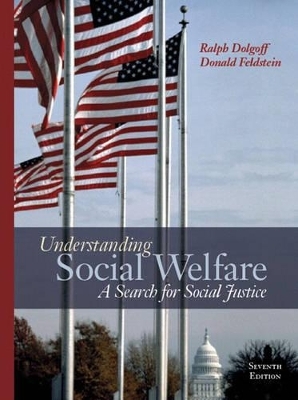
Understanding Social Welfare
Pearson
978-0-205-47806-4 (ISBN)
- Titel erscheint in neuer Auflage
- Artikel merken
The text focuses on the impact of social structure on peoples’ lives, emphasizing human rights and the search for social justice based on the current concerns of a diverse client population, and incorporating the latest contextual factors and social welfare legislation.
Most chapters include "Overview," "Summary," "Questions for Consideration," and "Notes."
1. Socio-Economic Structure, Human Needs, and Mutual Responsibility.
The Impact of Social and Economic Structures.
Defining Social Welfare and Social Work.
The American Myth of the Hero.
Balancing Individual and Societal Responsibilities.
Human Rights, Social Justice, Social Work, and Social Welfare
The Authors' Perspective.
2. Social Values and Social Welfare.
Modern Views of Humanity.
Self-Actualization versus Irritation Response Theories.
Economics and Human Motivation.
An Overview of History.
Altruism and Mutual Aid.
Ancient Cultures.
Hebrew and Judaic Societies.
Greece and Rome.
Early Christianity.
Holy Poverty and Expectations of the Wealthy.
Eastern Cultures.
3. Social Values and Social Welfare: Englandfrom the Middle Ages Onward.
The Early Middle Ages.
The Middle Middle Ages.
The Late Middle Ages to Elizabethan Poor Laws.
Work and Religion.
The Poor Laws.
The Poor Law Compilation of 1601.
Speenhamland.
The Workhouse.
The Poor Law of 1834.
Principles of the Poor Laws.
4. Social Values and Social Welfare: The American Experience I.
American Poor Law Mentality.
Settlements, Labor, and Imported “Poor Laws”.
The Early Spanish Influence, The Mexicans, and Other Latinos.
Voluntary Mutual Aid Efforts.
Mutual Aid among African Americans.
Voluntary and Public Responsibilities.
The American Frontier: The Myth and Values.
American Indians and U.S. History.
The Federal Role in Social Welfare.
The Freedmen's Bureau.
Veterans and a Suspension of the Ethic.
Social Darwinism.
The Coming of Social Insurance.
Society, Social Values, and Modern Views of Human Nature.
5. America, Poverty, Two Paths: The American Experience II.
Three Discoveries of Poverty.
First Discovery.
The Fading of the First Discovery.
Second Discovery.
Third Discovery.
The War on Poverty.
Expectation and Delivery.
The "Skirmish" Against Poverty.
Families, Children, and Poverty.
Aid to Families with Dependent Children (“Welfare”)
An Old-New Path.
Social Security.
Contrasting Values and Aims.
The Poor Laws Today.
Human Nature and the American Dream.
6. Concepts for Social Welfare.
What Is Social Welfare?
Social Policy, Social Services, and Social Work.
Ideology, Social Policy, and Government Intervention.
Five Routes to Social Policy.
The Federal and Pluralist System.
The Economic Sphere.
Fiscal Policy.
Monetary Policy.
The Importance of Fiscal and Monetary Policy.
A Tarnished Business Sector?
An International Economy.
A Second Welfare System: Corporate Welfare.
Changed World.
7. Examining a Social Welfare Program in the Context of Social Justice: Structural Components, Alternative Program Characteristics, and Evaluation.
Structural Components.
Alternative Program Characteristics.
What Are the Needs and Goals to Be Met?
What is the Form of Benefit That the Program Produces?
Who Is Eligible for the Program?
What Is the Level of Administration?
Alternative Program Characteristics.
Residual, Institutional, Developmental, or Socio-Economic Asset Development.
Selective or Universal.
Benefits in Money, Services, or Utilities.
Public or Private.
Central or Local.
Lay or Professional.
Evaluating the Program.
Adequacy.
Financing.
Coherence.
Latent Consequences.
Testing for Social Justice.
8. The Welfare Society and Its Clients.
Who Is a Client of Social Welfare?
What Is Poverty?
Absolute Poverty.
Relative Comparison Poverty.
A Description of the Poor.
Income and Wealth Inequality.
The Effect of Some Government Programs.
The Near-Poor and Expectations.
Other Views of Poverty.
Relative Inequality.
Lack of Power, Access, and Inclusion.
The Underclass/Culture of Poverty Thesis.
Strategies for Fighting Poverty.
Social Utilities.
Investment in Human Capital.
Income Transfers.
Rehabilitation.
Aggressive and Selective Economic Measures.
Participation and Organization.
Ideology Revisited.
The Bush Administration.
Ideology Once Again.
9. Current Social Welfare Programs: Economic Security.
Social Insurance Programs.
Social Security (OASDI).
Unemployment Compensation.
Workers’ Compensation.
Income Support Programs.
Temporary Assistance for Needy Families.
Supplemental Security Income.
General Assistance.
Earned Income Tax Credit.
Socio-Economic Asset Development.
10. Social Welfare Programs: Sustaining the Quality of Life.
Managed Care: A Radical Change.
Major Organizational Types.
Impact on Services and Practitioners.
Proponents.
Criticisms.
Research on Quality of Care.
Strategies to Achieve Profits.
Public Criticism and Legislation.
Health Care Programs.
Nutrition Programs.
The Food Stamp Program.
Special Supplemental Nutrition Program for Women, Infants, and Children.
School Lunch and Breakfasts Programs.
Low-Income Home Energy Assistance.
Housing.
Veterans' Benefits.
Employment Programs.
Personal Social Services.
Services to Families.
Services to Children.
Defense Department Social and Mental Health Services.
Title XX.
Mental Health Services.
Corrections.
11. Nonprofit and Private Social Welfare.
Early Patterns.
The Nonprofit Sector.
Types of Nonprofit Agencies.
The Proprietary Private For-Profit Organization.
Services of the Nonprofit and Private Sectors.
Getting and Spending.
Private and Nonprofit Agencies as Social Welfare Programs.
Who Is Eligible for the Program?
What is the Form of Benefit?
How Are the Programs Financed?
What Are the Levels of Administration?
A Point of View.
Leadership, Class, and Gender.
Private and Public Spheres.
Uses of Public Funds and Power.
Tax Laws and Policy.
Programmatic Links.
Accountability.
National Policy: Church and State.
Marketplace and the Nonmarket Domain.
Family and Friends.
Toward the Future.
12. Social Work: The Emergence of a Profession.
The Workers of "Good Works."
The Process of Professionalization.
A Brief History of Practice and Methods.
Development of the Professional Association.
Social Work with Groups.
Community Organization and Social Planning.
Toward a Unified Profession.
13. Social Work: Functions, Context, and Issues.
The Purposes of Social Work.
The Professional Within Complex Organizations.
Complex Organizations and Authority.
Complex Organizations and Professional Autonomy.
Alternative Roles and Settings.
Society, the Functions of Social Work, and Services for the People.
The “Bottom Line”.
The Two Tracks of Social Work: Cause and Function.
Generic-Specific Social Work.
Professionals and Volunteers.
The Number of Social Workers.
Issues Confronting the Profession: Leadership, Race, and Ethnicity, Accountability, and Empirical
Evidence.
14. Social Trends Affecting Social Welfare.
A National Society.
Individual and Shared Goals.
Trends.
An International Economy.
Population Growth and Resources.
The United States: A Changing Population.
Productivity and the Service Economy.
Ethnicity and Pluralism.
Gender.
Gay Men and Lesbians.
The Place of Social Welfare in a Changing Context.
15. Toward “the General Welfare” and Social Justice.
Globalization and Social Justice.
Disparities in Health and Health Care and Social Justice.
Elder Abuse and Social Justice.
A Second Welfare System: Corporate and Taxpayer Welfare and Social Justice.
Retaining Social Justice.
Alternatives Facing the Practitioner.
Technology and Social Action.
Where We Are.
Appendix: Sources of Other Information.
Index.
| Erscheint lt. Verlag | 24.8.2006 |
|---|---|
| Sprache | englisch |
| Maße | 178 x 235 mm |
| Gewicht | 803 g |
| Themenwelt | Sozialwissenschaften ► Pädagogik ► Sozialpädagogik |
| Sozialwissenschaften ► Soziologie | |
| ISBN-10 | 0-205-47806-9 / 0205478069 |
| ISBN-13 | 978-0-205-47806-4 / 9780205478064 |
| Zustand | Neuware |
| Haben Sie eine Frage zum Produkt? |
aus dem Bereich



